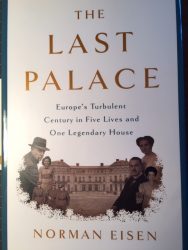Book review: THE LAST PALACE
I found the story told by Ambassador Norman Eisen in THE LAST PALACE fascinating for a number of reasons. Perhaps chief among them is the fact that I lived, for the first twelve years of my life, less than ten miles from this place—one known as “the last palace constructed in Europe”—totally unaware of its existence. Otto Petschek, an assimilated and wealthy Czech Jew (much like the Jewish side of my own family), devoted much of his fortune to building an architectural marvel on a hillside in Prague. He appointed it with expensive furniture, decorations, and valuable books. He micromanaged the entire process, including the landscaping, despite red tape and resentment by both the bureaucracy and many of the capital city’s citizens.
While the author’s telling of the building of Petschek’s legendary palace is fascinating, it is Eisen’s use of the grand mansion as an eye through which the reader sees the tortured history of my native country, the former Czechoslovakia, that makes this book great. He does this masterfully by following the lives of five inhabitants of the last palace.
First, of course, is the family of Otto Petschek. Following the occupation in 1939, the mansion was occupied by the Germans’ military attaché, Rudolf Toussaint, a Wehrmacht officer who walked a fine line between appeasing his Nazi bosses and his own feelings as a decent human being. Eisen’s meticulously researched book makes use of Toussaint’s tenure in the palace to describe life in Prague during more than six years of German occupation. Although I was hidden as a child outside of Prague during that time, and thought I knew a great deal about those times, I learned a great deal more by reading THE LAST PALACE.
The third occupant of the palace was U.S. Ambassador, Laurence Steinhardt, who moved in at the end of World War II and protected the house and its contents from ignorant, brutal soldiers of the Red Army, the new occupants of Prague. Even more importantly, the book describes Steinhardt’s unsuccessful attempts to save democratic Czechoslovakia from a Communist take-over.
Shirley Temple Black happened to be in Prague in August 1968, during what turned out to be the last days of Prague Spring. She witnessed the invasion by Warsaw Pact armies and, as a result, the former child star became determined to return someday as an American diplomat and to help the Czechs overthrow their latest oppressors. She did so when the elder President Bush named her Ambassador to Czechoslovakia. With the U.S. now owning the Petschek Palace, she became its newest occupant and, as such, provided support to dissidents who led the Velvet Revolution of 1989.
The book begins and ends with the author himself being named Ambassador to the Czech Republic by President Obama. Throughout its 360 pages, Eisen weaves in the story of his mother, Frieda, a Czech Jewish girl who dreamed of becoming a doctor before the Germans transported her to Auschwitz. She survived and immigrated to America, only to see her son become Ambassador to her native country. Her trepidation, mistrust, and resistance to even paying a visit to Prague reminded me of the feelings of my own mother following our immigration to the United States.
THE LAST PALACE is a wonderful book. It is meticulously researched and beautifully written—combining human drama with historical fact. I recommend it as highly as is possible.
